
Pi Day
by Jordin Lim
Another year, another Pi Day at Science Academy! Taking place Thursday, March 14th (3.14, of course), ASB hosted a highly successful Pi Day.
What is Pi Day? Read this article from last year for some irrationally fun Pi Day history!
https://www.thescienceacademystemmagnet.org/2023/03/22/pi-day-article/
Students enjoyed an extended lunch with fan-favorite festivities, such as a pie eating contest, carnival games, and the renowned throw-pie-at-teachers activity. Shout out to the students who, according to the accounts of Mr. Shepherd and Mr. Park, hit them square in the face, which was quite a challenge considering the wind!




The carnival games were a wonderful way to spend our lunch. Fellow students running the booths were bursting with energy and made the game-playing experience extra fun. But the cherry on top was the multitude of prizes I saw students return to class with. One of my classmates showed up to 5th period with a whole grocery bag of little stuffed animals!
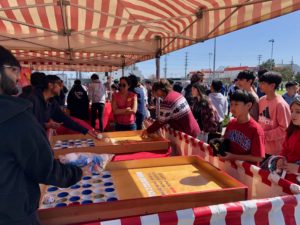
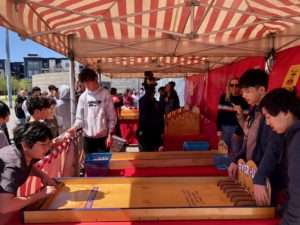
Hungry? Well, there were also tables set up where ASB offered students refreshments, pre-ordered pizza, and of course, plenty of pie.
This year, the seniors presented the student body with a new game. With the opportunity of winning $50 and $25 gift cards, we were to get the signatures of as many seniors as possible, who were designated with signs and cool hats. I found this to be an incredible activity! This allowed students of all grade levels to get to know the seniors. I saw a ton of students running around, trying to find as many seniors as they could.

Even if all these activities didn’t catch your eye–though I’m not sure how they wouldn’t– the extended lunch was an excellent opportunity to play around with your friends. I saw plenty of students enjoying their lunch playing volleyball on the blacktop or football and soccer on the field. I can’t wait for next year’s Pi Day and all the fun activities ASB has in store, and I bet the student body can’t either!
Read More
Lunar New Year Fun
by Desmond Devine and Ryan Park
To kick off the month of February, the Science Academy ASB celebrated Spirit Week from February 5th to the 9th. On Monday it was Pajama Day, Tuesday was Paint the Town Red Day, Wednesday was Jersey/College Day, Thursday was Twin Day, and Friday was Culture Day. Friday was particularly chosen as Culture Day to celebrate the Lunar New Year, which is the Year of the Dragon. To celebrate the Lunar New Year, the Korean Parent Organization prepared different dishes and fund activities for students to enjoy.
 As students walked down to the cafeteria, they were greeted by a traditional performance of janggu, Korean drums, and buk, another type of drum. Students then stood in line as they eagerly waited to receive a bowl full of Korean dishes. In each bowl, the Korean Parent Organization put in bulgogi (불고기- grilled marinated meat), japchae (잡채- stir-fried glass noodles), and rice (밥). As a little dessert, students were also given ppeongtwigi (뻥튀기 – sweet puffed grains). There were also various activities to keep the students entertained, the most interesting being Tuho (투호). Tuho is a very traditional game where participants attempt to throw arrows into a canister from a certain distance away. Another popular game has recently become very well known due to the hit TV show Squid Game. Ddakji (딱지) is a game where players have to use their origami squares to try and flip the other player’s origami square. The last activity was jegichagi (제기차기), where the goal of the game is to keep a shuttlecock wrapped in paper in the air for as long as possible. The first part “jeggi-” means an object used in play, and “-chagi” means to kick something.
As students walked down to the cafeteria, they were greeted by a traditional performance of janggu, Korean drums, and buk, another type of drum. Students then stood in line as they eagerly waited to receive a bowl full of Korean dishes. In each bowl, the Korean Parent Organization put in bulgogi (불고기- grilled marinated meat), japchae (잡채- stir-fried glass noodles), and rice (밥). As a little dessert, students were also given ppeongtwigi (뻥튀기 – sweet puffed grains). There were also various activities to keep the students entertained, the most interesting being Tuho (투호). Tuho is a very traditional game where participants attempt to throw arrows into a canister from a certain distance away. Another popular game has recently become very well known due to the hit TV show Squid Game. Ddakji (딱지) is a game where players have to use their origami squares to try and flip the other player’s origami square. The last activity was jegichagi (제기차기), where the goal of the game is to keep a shuttlecock wrapped in paper in the air for as long as possible. The first part “jeggi-” means an object used in play, and “-chagi” means to kick something.

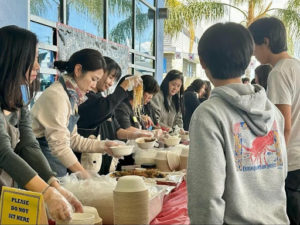
Celebrating the Lunar New Year had been a yearly tradition for the Science Academy before the pandemic hit and students had to go into remote learning. It’s wonderful to see the student body bond over food and games while they also experience some of Korean culture. Lots of appreciation to the Korean Parent Organization (KPO) for organizing such a great event and feeding all our students!
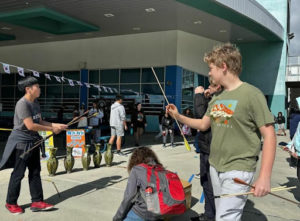

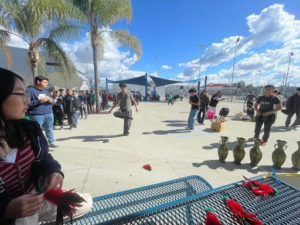

Holiday Door Contest
It’s beginning to look a lot like….a Winter Wonderland!!!
Congrats to all the participants in adding some fun holiday cheer to our hallways this season
The winners are:
* Most Festive: Mr. Shepherd
* Most Creative: Mr. Lamb
* Most Immersive: Ms. Huyler
* Student Favorite: Mr. Sanders
* Student favorite runner up: Ms. Tanguay

The Fall Season
by Liz Zarikyan
Did you know catching a falling leaf is said to be good luck? Fall is a season full of comforting traditions and overall nostalgic feelings. In the Northern Hemisphere, fall occurs during the months of September, October, and November. The start of the fall season is officially declared on the Autumnal Equinox, when the sun’s position is directly over the Earth’s equator, creating equal amounts of daylight and nighttime hours. This date falls on September 22nd or September 23rd. Fall continues until the Winter Solstice, which occurs annually on December 21 or 22.

Fall is also known as autumn and the harvest season. Fall is often called the harvest season as this is when many crops became ripe and farmers found that it more beneficial to harvest these crops in the cooler months after summer ended. The word autumn comes from the Latin word “autumnus”, which means “the passing of the year” and describes the position of the season in the annual calendar. Finally, the word fall is short for “fall of the leaf” since deciduous trees tend to lose their leaves in September and October, which allows trees to expend less energy through the harsh winter months and conserve moisture within the trunk.

2019 Six Flags Fright Fest
There many popular themed events that occur during this time. These include amusement parks with dedicated displays for the spooky Halloween season. Six Flags has an event known as Fright Fest, where you can enjoy the thrill of rides during the day before experiencing their frightening night attractions, which includes scare zones, live entertainment, roller coasters, and more. If you’re looking for something more family related, they offer family-friendly events and food during the day. Knotts Scary Farm and Universal Studios Halloween Horror Nights offer similar experiences, so you can pick and choose from your favorite amusement park.
If you’re looking for something slower-paced, try the Electric Dusk Drive-In in Glendale, where you can experience horror-themed movies in the comfort of your own car. Info: https://www.electricduskdrivein.com/ If you’re a fan of artifacts from the San Fernando Valley, visit the Valley Relics Museum where they offer a Halloween open air museum every Saturday and Sunday: https://valleyrelicsmuseum.org/. Or maybe you’d prefer an outdoor area with stunning scenery. This is exactly what Lavender Nights offers. 123 Farm in Cherry Valley transforms into a lit-up lavender farm containing over 30,000 lights. Experience the romance of the night while you stroll through their gardens, enjoy food and live music, and much more now through October 29th, Thursday – Monday from 5-10pm. https://www.123farm.com/lavendernights
However you celebrate, have a Happy Fall!
Read More
Asian American and Pacific Islander Heritage Month
by Ryan Park
During the month of May, the United States recognizes Asian American and Pacific Islander Heritage Month. This celebration, spanning from May 1st to May 31st, honors the contributions and accomplishments of Asian Americans, Pacific Islander Americans, and Native Hawaiians.
Why the month of May?
In 1990, President George H.W. Bush signed a bill that was passed by Congress to expand Asian American Heritage Week into the entirety of the month. Two years later, it was renamed Asian American and Pacific Islander Heritage Month to recognize the contributions of all Americans of Asian descent. The month of May was chosen because it commemorates the first immigration of Japanese Americans on May 7, 1843. In addition, it commemorates the completion of the transcontinental railroad on May 10, 1869, as Asian immigrants made crucial contributions to our country’s first coast-to-coast railway.
Making their Mark in America
An important aspect of the commemoration of AAPI Heritage Month is sharing the many life stories of those of Asian descent.
Born May 31, 1912, Dr. Chien-Shiung Wu is a pivotal figure in the history of physics. An immigrant to the United States from China, she did important work for the nuclear Manhattan Project, helping to develop the process for separating uranium into uranium-235 and uranium-238 isotopes by gaseous diffusion. Wu studied nuclear physics at the University of California, Berkeley where she got the chance to learn from physicists like J. Robert Oppenheimer. She later went on to become the first female instructor in the Physics Department at Princeton University, and her contributions to experimental physics include the Wu experiment, which proved that parity is not conserved.

On March 12, 2023, at the 95th Academy Awards, Malaysian actress Michelle Yeoh made history by becoming the first Asian woman to win an Oscar for Best Actress for the film Everything Everywhere All at Once. You can also find her in other popular movies like Shang Chi; Crazy Rich Asians; Crouching Tiger, Hidden Dragon; and Wicked.

On that same day, Vietnamese-American actor Ke Huy Quan won the Academy Award for Best Supporting Actor for the same movie. Ke Huy Quan was the first Asian to win this award in 38 years! A fun fact is that Ke Huy Quan was the actor who played the part of Short Round, a young boy in the popular Indiana Jones movie series.

Chloe Kim, a Korean-American Olympic snowboarder, is the youngest woman to win an Olympic gold medal in snowboarding. In the 2018 Winter Olympics in Pyeong Chang, Chloe became a gold medalist in the women’s snowboard halfpipe at the age of 17 and later became a two-time Olympic gold medalist. Although she has taken a break from the sport, she is set to return to the 2026 Winter Olympics in Italy.

You can find out more on: https://www.asianpacificheritage.gov/
Read More
The Significance of the Month of Ramadan
by Tarisha Hasan
The holy month of Ramadan takes place on the 9th month of the Islamic lunar calendar. It is during this month that all Muslims observe a fast from before the Fajr, or early morning prayer, until after sunset and the Maghrib evening prayer. During a fast, it is forbidden to eat and drink, with increased emphasis placed on spiritual activities and self-restraint. At the end of this month, Eid-al-Fitr is observed as a celebration and festival for enduring the month-long fast, which can be 29-30 days, depending on when the crescent moon is sighted. This year, Ramadan took place from the evening of March 22nd to the evening of April 20th. If you want to wish someone well during this time, you can say Ramadan Mubarak, which means “Blessed Ramadan”, or Ramadan Kareem, which translates as “Generous Ramadan.“
Why is the month of Ramadan important?
The month is important because fasting during the month is one of the five pillars of Islam. Because of the abstinence from worldly things and desires until the sunset of each day, it also enables communities to unite and comfort one another as we focus on our faith. There is also a strong basis for fasting in the Islamic holy book of the Qur’an and the accompanying Hadith:

- O you who believe! Fasting is prescribed for you as it has been prescribed for those who have believed before you (Surat Al-Baqarah, 2:183)
- It was the month of Ramadan in which the Qur’an was first sent down as guidance for all people, having in it clear proofs of divine guidance and the criterion for right and wrong. So whoever among you bears witness to the month shall then fast it (Surat Al-Baqarah, 2:185)
These quotes from the Qur’an make fasting during this holy month obligatory. The Hadith is the collected traditions of the Prophet Muhammad, based on his sayings and actions. The Hadith support for this is also strong, as shown in the following quote:
- God has said: “All the works of the Son of Adam are for himself but fasting. It is for Me alone, and I shall grant reward for it.” The fast is a safeguard from the Fire. So if ever it is a fasting day for any of you, there shall be neither sexual intimacy nor angered yelling. So if another should trouble or fight someone fasting, let the faster say: “Indeed, I am someone who is fasting.” For by the One in whose Hand is Muhammad’s soul, most surely the faster’s reeking mouth is better to God than the scent of musk. For the faster, there are two joys to rejoice in: When one breaks the fast, one rejoices. And when one meets one’s Lord, one shall rejoice in one’s fasting (Bukhari, no. 1904).
Bukhari is considered to be one of the five individuals who writes the authentic Hadith, but the support for the requirement of fasting still remains strong regardless of the Hadith source. It is important to know that despite the importance of the fast, there are classes of people who are exempt:
- The elderly/disabled or those unable to care for themselves
- Those suffering from serious illness that would hamper their ability to perform the fast
- Children before puberty
The name of the month of Ramadan has its origins in the Arabic word ramad, which translates literally to “dryness”. In ancient Arab times, this lunar month would often be the most difficult to endure due to the extremely high temperatures, especially since Arabia is a desert. Although fasting is one of the main priorities of this lunar month, the real spirit of Ramadan lies in truly understanding the Qur’an and the lessons it has to teach us. What’s more, it also gives one the opportunity to relive the sending down of the Qur’an, which contains the revelation of Islam.
What happens at the end of the month of Ramadan?
The fast is completed at the sighting of the new moon. The observance at the end of the month of Ramadan is known as Eid-al-Fitr. During this festival, all Muslims go to a nearby specialized mosque service in their community in order to carry out the Eid prayer. Before the Ramadan prayer, it is required to give a donation known as a Fitrah. This obligatory donation allows those Muslims in poverty to enjoy Eid-ul-Fitr like all other Muslims. Of course, you have to at least enjoy some sweet desserts during this festival, as this day is also known as “Sweet Eid”. 
There are also plenty of social activities to do, such as gifting fellow Muslims presents, purchasing new clothes, and especially giving to those less fortunate. The main theme of Eid is giving thanks after a long month of fasting. It also centers on spending more time with friends and family. There is no set menu, but the foods should be adequately prepared and also be filling. The clothing is also an important part, because Muslim families around the world always dress their best for the occasion, often in traditional outfits.
In addition, there is also visiting the graves of relatives in order to honor and remember them. In the case of Muslim-majority countries, there are shopping sprees at special “Ramadan markets” as well as local malls. It goes even further; schools are closed as well as businesses. Flowers and decorations adorn homes, and there is a general celebration with good food and good company. This festival isn’t just one day: it can last for up to three to four days, depending on the country’s time zone and regulations. And of course, Eid-al-Fitr is celebrated differently in different countries. The similarities are all shared: the holiday is essentially a new start, regardless of who observes it or where they do it.
Personal Experience
Although the Ramadan fast is meant to be rigorous, by no means is it meant to be difficult. I find it relatively comfortable as I take proper measures to ensure adequate hydration during the morning meal before the fast. I also prioritize a relatively heavy early morning meal as the fast lasts until the evening, which would make approximately 16 hours total, give or take a couple hours. The fast isn’t just about restricting food intake for me, however. It’s also about kicking bad habits to try and better myself. Despite this, I do look forward to Eid, when we will celebrate the completion of the fast.
It’s not just about restricting food and drink. It’s also about learning to control my emotions in order to better myself. More importantly, it helps me realize that all the things that I thought were highly important are actually just trivial matters that I should not waste time worrying about. Fasting also teaches me how to be nicer to people, or sometimes just ignoring the people that aren’t worth my time. I find myself free to do other things, as well as not being obligated to go downstairs for lunch or nutrition if I carry out the fast during school hours.
In terms of physical distress, my main concern is during P.E., when thirst and dehydration are common concerns. However, I just concentrate on doing my best regardless. Many advise that athletes should be certain to let their teachers and coaches know when they are fasting so they can take it into account with regards to activities and rest as needed. Overall during Ramadan, I invest nearly all my time and energy into quickly finishing assignments. The evening meal is a typical meal that often has chickpea curry along with salad and some fruit. Overall, Ramadan seems relatively commonplace to me, but nevertheless, I look forward to Eid and the festivities.
Read More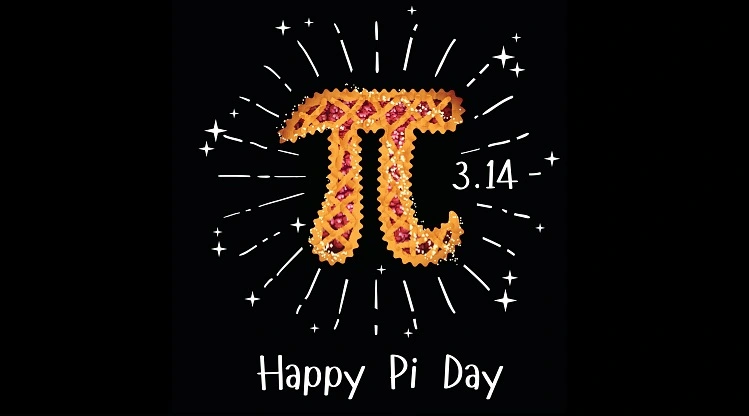
Pi Day Fun!
by Jordin Lim
 Pi Day, celebrated March 14, is the celebration of mathematical constant 𝝅, due to its numerical date (3.14) representing the first three digits of pi.
Pi Day, celebrated March 14, is the celebration of mathematical constant 𝝅, due to its numerical date (3.14) representing the first three digits of pi.
Fun fact: Pi Day also happens to be Albert Einstein’s birthday
Physicist Larry Shaw, who found Pi Day in 1988, had the first Pi Day celebration at his place of work, the Exploratorium, a San Francisco-based interactive science museum. However, Pi Day was not deemed a national holiday until 2009, after the U.S. House of Representatives passed legislation making it one.
 Pi Info
Pi Info
Although our Science Academy students are more than well-acquainted with pi, it is still useful to note what it is and its significance in everyday life.
What is pi?
Ancient Greek mathematician Archimedes is most commonly credited to be the first to accurately calculate the approximate value of pi. In mathematics, pi is the constant ratio of a circle’s circumference to its diameter, regardless of its size.
Fun fact: The word “pi” itself is derived from the first letter of the Greek word perimetros, meaning circumference.
What is the significance of pi?
Although you may not find yourself using pi every day, pi is used in many calculations for buildings and construction, engineering, and many other fields. In addition, NASA regularly uses pi to calculate trajectories of spacecraft. Not only that, but pi gives us a reason to feast on pie every March 14, although who really needs a reason to eat pie any day of the year?
Pi Day Festival
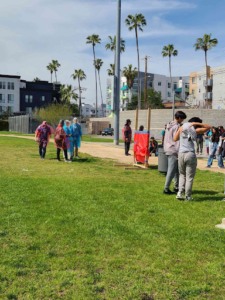 On March 17, Science Academy held our infamous Pi Day Festival, which had to be delayed to the new date due to rain on March 14. This festival consisted of many fun activities and carnival games, including ring toss, pie eating contests, and even throwing whipped cream pies at the teachers! (I saw a catapult at this event, and I hope it was used) In addition, there were other booths selling refreshments and giving students their pre-ordered pizzas.
On March 17, Science Academy held our infamous Pi Day Festival, which had to be delayed to the new date due to rain on March 14. This festival consisted of many fun activities and carnival games, including ring toss, pie eating contests, and even throwing whipped cream pies at the teachers! (I saw a catapult at this event, and I hope it was used) In addition, there were other booths selling refreshments and giving students their pre-ordered pizzas.
The prizes given out at the carnival games were quite great – many people entered their class after lunch bearing multitudes of stuffed animals – I personally won two lollipops myself.
I hear the Pi Day Festival is a fan favorite among the student body, so I can’t wait to see it again next year!
Photo Gallery
 .
. 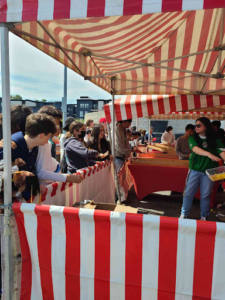



Read More

Happy Valentine’s Day!
by Desmond Devine, NewsFlash Resident Curmudgeon
Valentine’s Day has come once again to entice and torment us all, so it’s time to unravel the tangled history of the holiday. But before that, we must acknowledge the first ASB event of the year: the Love and Kindness Fest. Taking place during an extended lunch (yay!), activities included games such as cornhole and sack races, a scavenger hunt, flower bouquet crafting, and a marriage booth with Polaroid mementos. Much fun, pizza, and candy were had by all!

Leading up to Love Fest, we celebrated a Love and Kindness Spirit Week, which included:
Heart Day: Everyone received a heart-shaped pin — strike that — bracelet to wear during first period — um, wait — seventh period on Monday — nope, make that Tuesday — and guffawed at each other’s corny messages for the rest of the day.

If the pins had this message, I’d wear one every day.
Pajama Day: The obligatory classic. We all know and love this one.
Duo Day: Students wore matching outfits with somebody else. Seems to be an adaptation of the Discord trend.*
*Disclaimer: Nothing stated in this article should be construed as an endorsement or acceptance of the evil scourge known as Discord.
Rose Day: Students were asked to wear Red, Pink, or White outfits to mimic the colors of roses. ASB should know, however, that roses can be yellow and purple, too!

This isn’t just a random image from the internet. I swear, I have a yellow rose bush in my own backyard!
Tie Day: The exact opposite of Pajama Day, where people dressed as if they were going to an actual wedding.
 Comfort or style? You decide.
Comfort or style? You decide.
So where does all this celebration of love come from, you may ask? We’re always told that Valentine’s Day is named after St. Valentine, but who exactly is it referring to? There are actually many saints named Valentine or a name similar to Valentine. The name derives from the Latin word “Valentinus”, meaning powerful. One popular tale depicts a priest named Valentine who went against an unjust law formed by Emperor Claudius II in third century Rome, which prohibited young adults from being married. This Valentine was executed for continuing to marry younger couples. A bishop, St. Valentine of Terni, who was also executed by Claudius II, is another potential contender.

St. Valentine healing prisoners. St. Valentine is the patron saint of epilepsy, and some believed that he helped or even cured people with the disorder.
One legend states that, while Valentine was on death row, he fell in love with his jailer’s daughter, who he had cured of blindness, and sent her a letter addressed “From Your Valentine”. In the story, this would be the first valentine ever sent.
Valentine’s Day is believed to have originated from the celebration of Lupercalia. It took place on February 15th, honoring the Roman god of agriculture, Faunus. Traditions included sacrificing a goat, soaking its hide in its blood, and brushing the hide against crop fields for fertility. This holiday was banned by Pope Gelasius in the fifth century for being paganistic, i.e. just a bit too bloody, and soon the 14th of February was declared St. Valentine’s Day.
It wasn’t until the Middle Ages that Valentine’s Day was associated with love. In France and England, people believed that February 14th was the start of birds’ mating seasons, and a poet named Geoffrey Chaucer wrote Parliament of Foules, the first written work that described Valentine’s Day as a celebration of romance. It was written in 1375, an interesting coincidence due to that being in the 14th century. In the 1400s, valentine greetings started to become popular. The oldest one was written in 1415 by Charles, Duke of Orleans, to his wife, while he was in the Tower of London as a prisoner of the Battle of Agincourt.

This is the actual valentine of 1415. Cue the “And I can’t even get a text back” jokes!
A long time later, during the mid-18th century, it became commonplace for all types of people to exchange valentines. The mass production of valentines became a profitable business, with Valentine’s Day cards emerging in the early 20th century. And so, Valentine’s Day went from a day of simply expressing love for others to a breeding ground for companies like Hallmark, which sells around 131 million cards a year along with Christmas ornaments and home decor. And don’t forget those corny Christmas films!
Commercial aspects of the modern Valentine’s Day
As mentioned, Valentine’s cards are very popular with people who celebrate the holiday, with around 190 million valentines being sent every February 14th, the second-most for any holiday observed in the US, surpassed only by Christmas. This amount doesn’t include the millions exchanged at elementary schools between students. One billion dollars are spent on candy and chocolates, which include 36 million heart-shaped boxes of chocolates and 7 billion Sweethearts candies sold each Valentine’s Day. Necco, the company which started printing messages on heart-shaped lozenge candies in 1866, went bankrupt in 2018 and sold the candy to Spangler, which has been producing the candies since 2020.

Seriously, who would want to go out with someone who unironically likes these puns?
According to an Ipsos poll conducted in 2022, flowers gifted on Valentine’s Day account for 30% of the flowers sold for the entire year. Flowers are a widely known gift to give to a loved one on Valentine’s Day, with about 250 million roses being grown for the holiday alone. Red roses are greatly associated with love, and were considered the favorite flower of the Greek goddess of love, Aphrodite (known in Roman mythology as Venus). Fun facts: more men buy flowers for their beloved than women, and more women buy flowers for themselves than men.
While Valentine’s Day is more commercialized than ever before, we all should remember the original meaning of the holiday and take time to express our gratitude for our family, friends, and significant others. However, if you’re concerned about not having any significant others, no worries! Always remember…


The truth, and nothing but the truth
Happy Valentine’s Day!
Sources:
https://www.history.com/topics/valentines-day/history-of-valentines-day-2
https://www.britannica.com/biography/Saint-Valentine
https://www.history.com/news/6-surprising-facts-about-st-valentine
https://epilepsysociety.org.uk/blog/link-between-saint-valentine-and-epilepsy
https://web.archive.org/web/20060506195745/http://www.necco.com/AboutUs/History.asp
https://safnow.org/aboutflowers/holidays-occasions/valentines-day/valentines-day-floral-statistics/
Read More
Kwanzaa
by Milan Riley
Kwanzaa is an annual celebration of African American culture that is celebrated in many areas affected by the African Diaspora. Lasting one week, Kwanzaa occurs from Monday, December 26th, to Sunday, January 1st of the next year. The event revolves around Pan-Africanism, unity, creativity, faith, and giving gifts. The term ‘Kwanzaa’ came from a Swahili phrase, matunda ya kwanza, meaning ‘first fruits.’

History of Kwanzaa
Kwanzaa was created by Maulana Karenga, an American activist and author. In 1966, Karenga started the holiday as a way for African-American families to reconnect with their historical origins and embrace their community. Karenga was inspired by civil rights rebellions, such as the Watts Riots, in addition to another observance, Umkhosi Wokweshwama, an annual harvest festival for the Zulu people.
 Mauluna Karenga
Mauluna Karenga
Traditions
Karamu is a feast commonly on the 6th day of Kwanzaa, December 31st. Families add one ear of corn for each child in the family, along with seasonal fruits to their main dish, a one-pot stew. Participants drink from the unity cup, also called kikombe cha umoja, in tribute to their ancestors.
 Karamu Meal
Karamu Meal
Giving gifts to children in exchange for their good deeds over the year is also customary. Handmade presents and symbols of their ancestry, such as jewelry from Africa, are common. Books or other objects that teach the next generation about their roots are recommended.
 A traditional gift.
A traditional gift.
Another tradition during Kwanzaa is the lighting of the Kinara candleabra, which consists of black, green, and red candles, which matches the colors of the Pan-African flag. The seven candles are lit one by one as the days of Kwanzaa go by. Each candle has a particular meaning that celebrated on that day, and they are lit in this order:

- Red candle meaning Umoja (unity).
- Red candle meaning Kujichagulia (self-determination).
- Red candle meaning Ujima (collective work and responsibility).
- Black candle meaning Ujamaa (cooperative economics).
- Green candle meaning Nia (purpose).
- Green candle meaning Kuumba (creativity).
- Green candle meaning Imani (faith).
Read More







